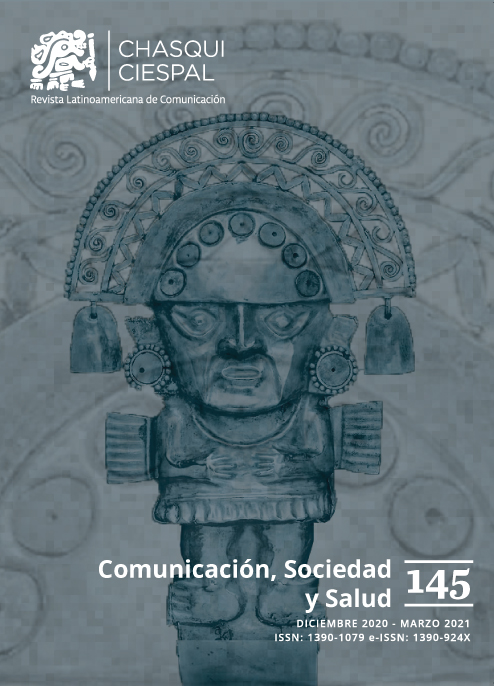Ciudades MIL, smart campus y e-salud: Prevención epidemiológica
DOI:
https://doi.org/10.16921/chasqui.v1i145.4370Keywords:
alfabetización mediática e informativa, Unesco, ciudades universitarias MIL, E-saludAbstract
La adopción del framework Ciudades MIL es una propuesta que engloba a las ciudades resilientes, inteligentes, saludables, creativas e innovadoras. En el presente trabajo se propone mostrar cómo la implementación de este paradigma podría contribuir a superar algunos de los problemas estructurales y de salud en las universidades. Para ello, se realiza un análisis exploratorio y comparativo utilizando 13 indicadores inspirados en el paradigma de las ciudades MIL, adaptado a las ciudades universitarias, profundizando en la universidad de Sao Paolo. Como resultado principal se evidencia que aún hay un largo camino por recorrer, antes de que puedan evaluarse los campus universitarios como inteligentes. Se concluye exponiendo que no existe una planificación preventiva sólida para combatir enfermedades y pandemias.References
Aaby, A., Friis, K., Christensen, B., Rowlands, G., & Maindal, H.T. (2017). Health literacy is associated with health behaviour and self-reported health: A large population-based study in individuals with cardiovascular disease. European Journal of Preventive Cardiology, 24(17), 1880-1888. https://doi.org/10.1177/2047487317729538
Chibás, F., Grizzle, A., Borges, A., Ramos, F., Mazzetti, B., Silva Junior, O. (2020). Métricas das Cidades MIL, Barreiras Culturais e Inteligência Artificial analisadas sob a visão da UNESCO: caso São Paulo. In: Yanaze, M., Chibás Ortiz, F. (Org.). Das Cidades Inteligentes às Cidades MIL, métricas inspiradas no olhar da UNESCO. ECA- USP: São Paulo
Caragliu, A., Del Bo, Ch. & Nijkamp, P. (2011). Smart cities in Europe. Journal of Urban Technology, 18 (2), 65-82.
Deng, Z., & Liu, S. (2017). Understanding consumer health information-seeking behavior from the perspective of the risk perception attitude framework and social support in mobile social media websites. International Journal of Medical Informatics, 105, 98-109. https://doi.org/10.1016/j.ijmedinf.2017.05.014
Galeano-Barrera, C., Bellón-Monsalve, D., Zabala-Vargas, S., Romero-Riaño, E, & Duro-Novoa, V. (2018). Identificación de los pilares que direccionan a una institución universitaria hacia un smart-campus. Revista de Investigación, Desarrollo e Innovación, 9(1), 127-145. https://dx.doi.org/10.19053/20278306.v9.n1.2018.8511
Guntzviller, L.M., King, A.J., Jensen, J.D., & Davis, L.A. (2017). Self-efficacy, health literacy, and nutrition and exercise behaviors in a low-income, Hispanic population. Journal of Immigrant and Minority Health,19(2), 489-493. https://doi.org/10.1007/s10903-016-0384-4
Grizzle, L. (2020). Ciudadanos AMI: Informados, comprometidos, empoderados. Gotemburgo: UNESCO.
Kumar, V (2020). Smart Living for Smart Cities: Community Study, Ways and Means. London: Springer.
Kwan, G., Shaw, J.A., & Murnane, L. (2019). Internet usage within healthcare: How college students use the Internet to obtain health information. Journal of Consumer Health on the Internet, 23(4), 366-377. https://doi.org/10.1080/15398285.2019.1681247
Lombardi, P.; Giordano, S. Farouh, H. and Yousef, W. (2012). Modelling the Smart City Performance. Innovation: The European Journal of Social Science Research, 25(2), 137–149.
Masilamani, V., Sriram, A., & Rozario, A. (2020). eHealth literacy of late adolescents: Credibility and quality of health information through smartphones in India. [Alfabetización en e-Salud de los jóvenes: Credibilidad y calidad de la información sanitaria con móviles en la India]. Comunicar, 64, 85-95. https://doi.org/10.3916/C64-2020-08
Maestre-Góngora, G. (2015). Revisión de literatura sobre ciudades inteligentes: una perspectiva centrada en las TIC. Ingeniare, 19(11), 137-149. https://doi.org/10.18041/1909-2458/ingeniare.19.531
NAÇÕES UNIDAS Brasil. (2020). Publicação de agências da ONU coloca a saúde no centro do planejamento urbano. Disponível em: https://bit.ly/2E9jDmU
ONU News. (2019). ONU prevê que cidades abriguem 70% da população mundial até 2050. Disponível em: https://bit.ly/3fZojZV
Ontiveros, E., Vizcaíno, D., y López-Sabater, V. (2016). Las ciudades del futuro: inteligentes, digitales y sostenibles. Barcelona: Ariel.
Romano, R. (2020). As Cidades Universitárias como Cidades MIL: Estudo de Caso do Centro Universitário FACENS. In: Yanaze, Mi; Chibás, F. (2020). Das cidades inteligentes MIL. Métricas inspiradas no olhar UNESCO.
Sikora - Fernández, D. (2017). Factores de desarrollo de las ciudades inteligentes. Revista Universitaria de Geografía, 26(1),135-152.
UNESCO. (2020).Home to the oldest university in the world. Disponível em: https://bit.ly/2Y5KV4U
UNESCO. (2020). Global Framework for Media and Information Literacy Cities (MIL Cities). Disponible en: https://bit.ly/2E6H1BK
UNESCO. (2019). MIL Cities metrics are being developed. In: Media and Information Literate Cities. Disponível em: https://bit.ly/3asTNXf
Vargo, C., Cole, R., & Minooie, M. (2014). The emerging papyrus society. Digital communication in the time of disclosure. http://bit.ly/2WjjgNO
Yin, R. (2011). Case study research: design and methods. Thousand Oaks: Sage.
Downloads
Published
Issue
Section
License
- Authors retain copyright and grant the journal right of first publication with the work simultaneously licensed under a Creative Commons Attribution-NoDerivs License (CC BY-ND) that allows others to share the work with an acknowledgement of the work's authorship and initial publication in this journal.
- Authors are able to enter into separate, additional contractual arrangements for the non-exclusive distribution of the journal's published version of the work (e.g., post it to an institutional repository or publish it in a book), with an acknowledgement of its initial publication in this journal.
- Authors are permitted and encouraged to post their work online.

